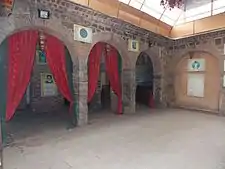Ghalib ki Haveli
28.6543099°N 77.2255774°E Ghalib ki Haveli (Urdu: غالب کی حویلی ALA-LC: G̱ẖālib kī Ḥawelī IPA: [ˈɣɑːlɪb kiː ɦəˈʋeːliː] lit. "Ghalib's Mansion") was the residence of the 19th century Urdu poet Mirza Ghalib and is now a heritage site[2] located in the Gali Qasim Jan, Ballimaran, Old Delhi and reflects the period when the Mughal era was on the decline in India.
غالب کی حویلی | |
A bust of the Urdu poet, Mirza Ghalib, at the Haveli | |
| Established | 27 December 2000[1] |
|---|---|
| Location | Gali Qasim Jaan, Ballimaran |
| Type | Memorial |
| Key holdings | Handwritten Poems of Ghalib |
| Collections | Bust of Ghalib |
| Public transit access | Chawri Bazaar Metro Station |
The house was given to him by Hakim, a physician who is believed was an enthusiast of his poetry. After the poet's death in 1869, Hakim used to sit there every evening, not allowing anyone enter the building.[3]
اگ رہا ہے در و دیوار سے سبزہ غاؔلب
ہم بیاباں میں ہیں اور گھر میں بہار آئی ہے
Transliteration (ALA-LC):
Ug rahā hai dar-o-dīvār se sabza 'ġhālib',
Ham bayābāñ meñ haiñ aur ghar meñ bahār aa.ī hai.[4]
It is roughly translated into English as:
"Greenery is growing out of the doors and walls, 'Ghalib'!
I am in wilderness and spring has arrived at my house."
About

Mirza Ghalib's Haveli is located in the Old Delhi and is a heritage site declared by Archaeological Survey of India. It offers an insight into the Mirza Ghalib's lifestyle and architecture of the Mughal Era.[5] The large compound of the Haveli with columns and bricks are the reminiscence of the Mughal Empire in Delhi. The walls are adorned with the huge portrait of the poet and his couplets which are hung around the side walls. After the takeover by the Delhi government the haveli was made into a permanent memorial museum housing objects related to the poet and his times. It also houses various hand written poems by the poet besides his books. The museum also houses a life size replica of the poet in a realistic setting with a hookah in his hand. Portraits of Ustaad Zauq, Abu Zafar, Momin, and other noted contemporaries of Ghalib can also be seen. On 27 December 2010, former Delhi Chief Minister Sheila Dikshit unveiled a sculpture of the poet that was sculpted by a well known artist Bhagwan Rampure and commissioned by poet and Hindi film lyricist Gulzar.[6] A portrait of Ghalib commissioned by the former president of India Dr. Zakir Husain served as the blue print for the sculpture.[7]
History
Ghalib lived in this Haveli for a long period of his life after he came from Agra. While staying at this Haveli, he wrote his Urdu and Persian ‘diwans’. Many a year after Ghalib's death the place housed shops inside it until the year of 1999 after which the government acquired a portion of it and renovated it. It was given a special touch with the use of Mughal Lakhori bricks, sandstone & a wooden entrance gate to recreate the 19th century period.[2]
Architecture
It is built using traditional material including lakhori bricks and lime mortar.[8][9][10][11]
Information
Located near Chawri Bazar metro station and Delhi Junction railway station it is open to all, with free entry and no photography charges, from 11 am till 6 pm on all days except Monday.
Gallery
 Genealogy of Ghalib as displayed at the Ghalib ki Haveli, Old Delhi
Genealogy of Ghalib as displayed at the Ghalib ki Haveli, Old Delhi Renovated roof Ghalib ki Haveli
Renovated roof Ghalib ki Haveli A page from Ghalib's Diwan reading "Ye na thi hamari qismat..."
A page from Ghalib's Diwan reading "Ye na thi hamari qismat..." Postal stamp in memory of Ghalib, Government of Pakistan
Postal stamp in memory of Ghalib, Government of Pakistan At Ghalib ki Haveli
At Ghalib ki Haveli Ghalib's favourite pastime
Ghalib's favourite pastime A visual projection of Ghalib during his leisure time
A visual projection of Ghalib during his leisure time A couplet on the wall
A couplet on the wall
See also
References
- "Ghalib ki Haveli". Archived from the original on 20 November 2013. Retrieved 22 January 2014.
- "Ghalib ki Haveli". Archived from the original on 25 December 2018. Retrieved 22 January 2014.
- "Lost in the Chaos of Chandni Chowk, Mirza Ghalib's 300-Year-Old Haveli is a Forgotten Treasure". The Better India. 27 December 2016. Retrieved 27 July 2020.
- "Read full ghazal by Mirza Ghalib". Rekhta. Retrieved 27 July 2020.
- "Mirza Ghalib's Haveli in Chandni Chowk, Delhi". Retrieved 22 January 2014.
- "Ghalib's marble bust unveiled". The Times of India. 27 December 2010. Archived from the original on 22 January 2014.
- "Ghalib's Legacy". 3 January 2013.
- "Haveli to speak of a history lost in time". Times of India. 21 December 2015.
- "5. Havelis of Kucha pati Ram, in South Shahjahanabad" (PDF). World Monument Fund.
- "Revival of Hemu's Haveli on the cards". Yahoo News India. 6 August 2015.
- "A Jail, school and orphanage: Bawana's fortress gets another makeover". Hindustan Times. 21 February 2017. Retrieved 26 August 2018.
